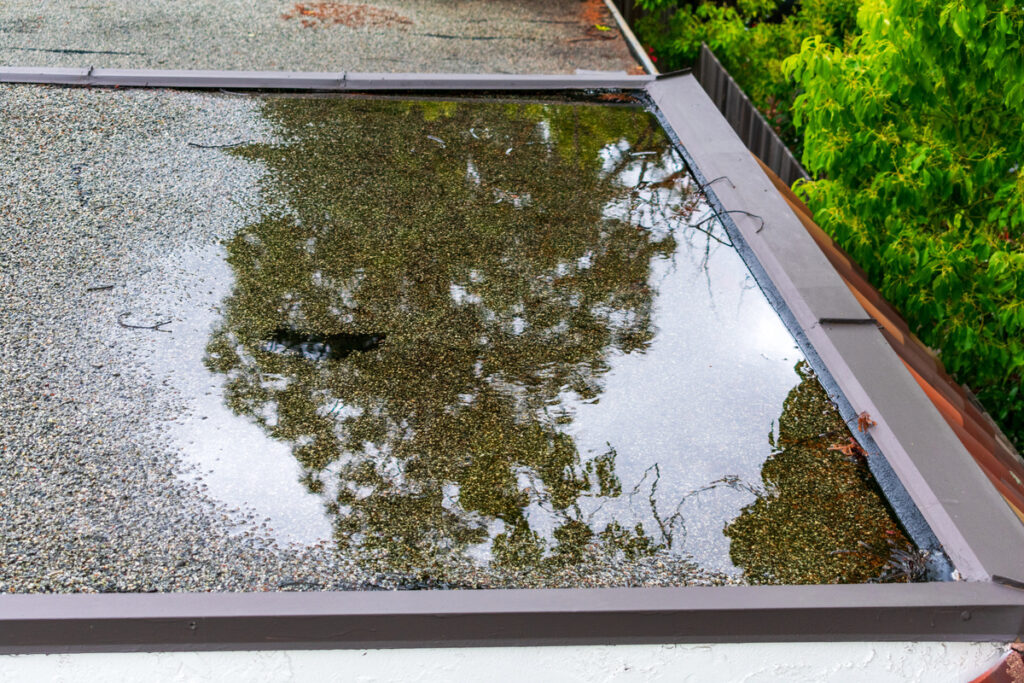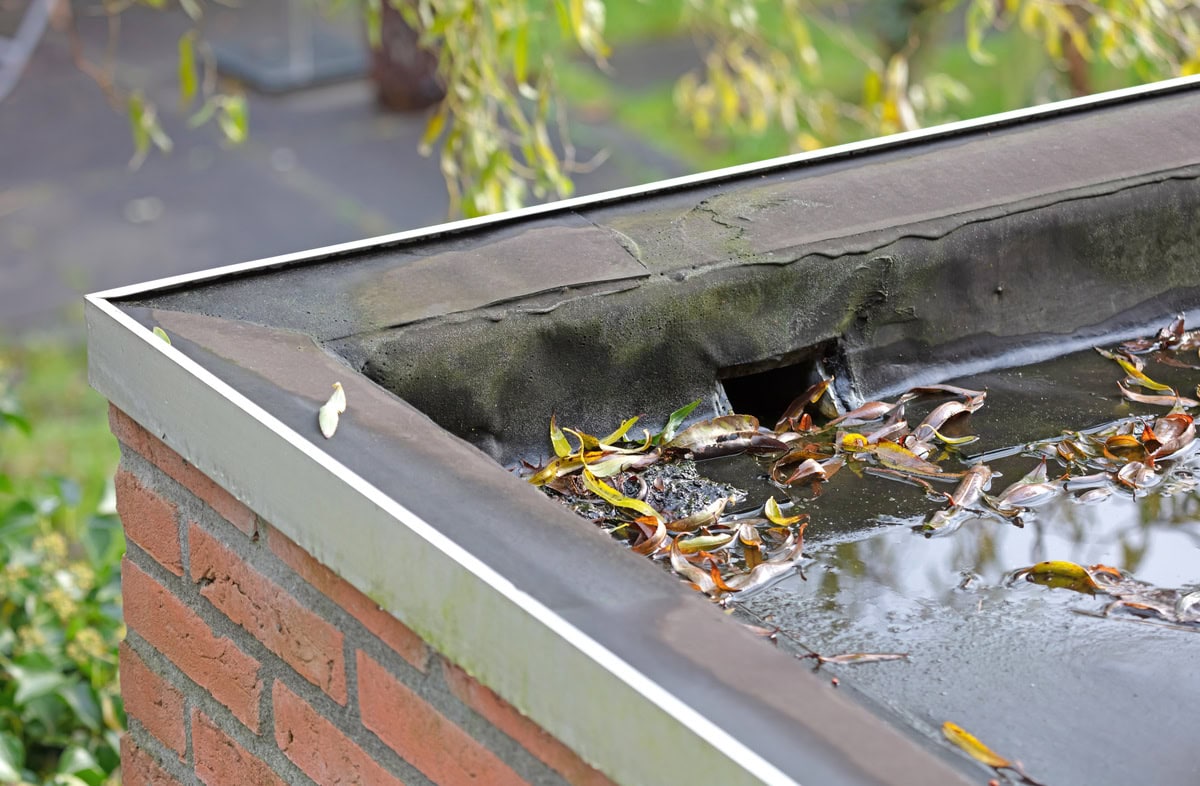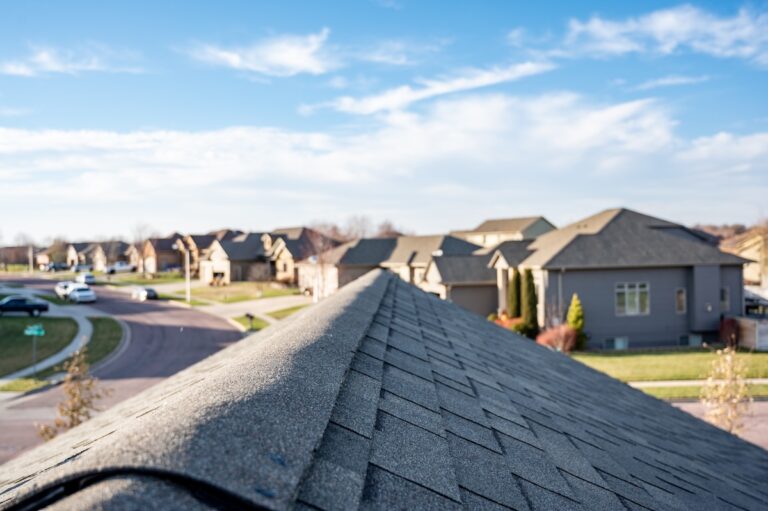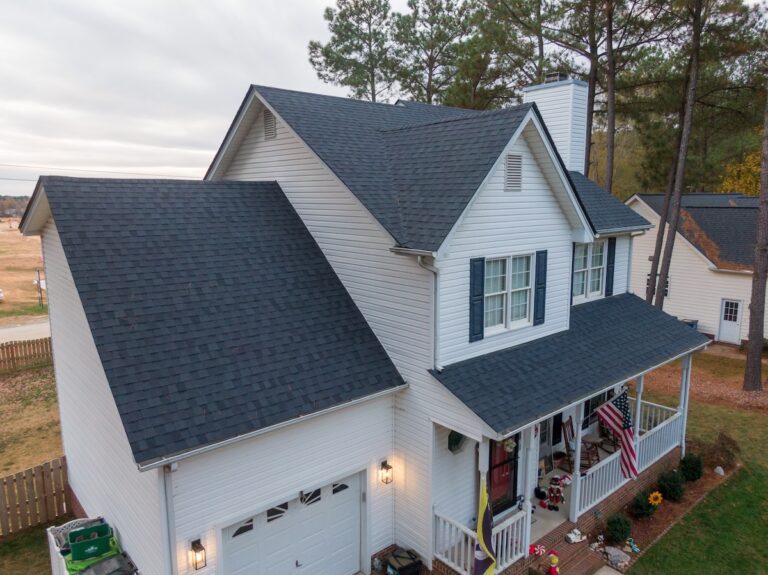Flat roofs, while aesthetically pleasing and space-efficient, come with their own set of challenges, particularly when it comes to drainage. Unlike pitched roofs, which naturally guide water away, flat roofs require effective drainage systems to prevent pooling and potential damage.
Want to know how it works? You’re in the right place. We’ve got all the facts you need to know about flat roof drainage, including:
- How it works
- Common issues
- Signs of poor drainage
- Associated dangers
- Solutions for improvement
- Replacement considerations
Keep reading to learn how improve the drainage system on your commercial flat roof!
Understanding Flat Roof Drainage
A flat roof, as the name suggests, has a very slight pitch or no pitch at all. Instead of water naturally flowing off, it relies on a drainage system to redirect water away from the roof surface. This system typically consists of:
- Gutters
- Downspouts
- Scuppers
- Drains strategically placed to facilitate water runoff
How Flat Roofs Drain
Flat roofs primarily rely on gravity to drain water. They feature a slight slope, imperceptible to the naked eye, directing water towards drains or scuppers located at low points on the roof’s surface. From there, water is channeled through downspouts or internal drains and ultimately directed away from the building.
Common Flat Roof Drainage Issues
Despite their design, flat roofs are susceptible to various drainage problems. These include:
- Clogged Drains and Gutters: Leaves, debris, and sediment can accumulate in drains and gutters, impeding water flow and causing backups.
- Ponding Water: Inadequate slope or blocked drainage can lead to water pooling or ponding on the roof’s surface, increasing the risk of leaks and structural damage.
- Damaged Membrane: Tears, punctures, or deterioration of the roofing membrane can compromise drainage, allowing water to infiltrate the roof structure.
- Insufficient Drainage Capacity: If the drainage system is undersized or poorly designed, it may struggle to handle heavy rainfall, leading to overflow and water infiltration.
4 Signs of Poor Drainage

Detecting signs of poor drainage early can prevent costly damage to your flat roof and building interior. Look out for these red flags:
1) Ponding Water:
Standing water on the roof lasting more than 48 hours indicates inadequate drainage.
2) Water Stains:
Interior water stains on ceilings or walls are often indicative of roof leaks caused by poor drainage.
3) Mold or Mildew Growth:
Excessive moisture resulting from poor drainage can promote mold and mildew growth, posing health risks and indicating drainage issues.
4) Sagging or Bowed Roof Deck:
Prolonged exposure to water can weaken the roof structure, causing it to sag or bow under the weight.
The Dangers of Poor Drainage:
Ignoring flat roof drainage issues can have serious consequences for both the roof and the building it protects. Some dangers include:
- Structural Damage: Prolonged exposure to standing water can compromise the integrity of the roof structure, leading to costly repairs or even collapse.
- Interior Damage: Roof leaks resulting from poor drainage can damage ceilings, walls, insulation, and electrical systems, requiring extensive repairs.
- Mold and Mildew: Excess moisture caused by poor drainage creates an ideal environment for mold and mildew growth, posing health risks to occupants and requiring remediation.
- Decreased Lifespan: Untreated drainage problems accelerate the deterioration of roofing materials, reducing the lifespan of the roof and necessitating premature replacement.
How to Improve Your Roof’s Drainage
Addressing flat roof drainage issues promptly is crucial to prevent further damage. Here are some effective solutions:
🫧 Clean Gutters and Drains Regularly:
Remove debris and sediment from gutters, downspouts, scuppers, and drains to ensure unobstructed water flow.
🔧 Install Additional Drains or Scuppers:
If existing drainage is insufficient, consider installing extra drains or scuppers to improve water runoff.
⌳ Modify Roof Slope:
In some cases, adjusting the slope of the roof or installing tapered insulation can enhance drainage and prevent ponding.
🧰 Repair Roof Membrane:
Patch or replace damaged roofing membrane to restore proper drainage and prevent water infiltration.
When to Replace Your Flat Roof
Despite diligent maintenance, flat roofs have a limited lifespan and may eventually require replacement. Consider replacing your flat roof if:
- It’s Reached the End of its Lifespan: Most flat roofs have a lifespan of 15 to 30 years, depending on the materials used and environmental factors. If your roof is nearing the end of its expected lifespan, replacement may be necessary to avoid costly repairs.
- Extensive Damage: Severe damage to the roofing membrane, insulation, or structural components may warrant roof replacement rather than repair.
- Persistent Drainage Issues: If drainage problems persist despite efforts to remediate them, it may indicate underlying structural issues that necessitate roof replacement.
Cost of Professional Repairs vs. Replacement
The cost of addressing flat roof drainage issues depends on the extent of the damage and the chosen solution. Here’s a comparison of professional repair and replacement costs:
Professional Repairs:
Repairing clogged drains, patching membrane leaks, and addressing minor damage typically costs between $500 to $1500, depending on the extent of the repairs.
Roof Replacement:
The cost of replacing a flat roof varies significantly depending on factors such as roof size, material selection, and labor costs. On average, expect to pay between $5 to $15 per square foot for a complete roof replacement.
Maintenance Tips for Flat Roofs
Regular maintenance is key to prolonging the lifespan of your flat roof and preventing drainage issues. Follow these maintenance tips:
- Schedule Annual Inspections: Have your flat roof inspected by a professional at least once a year to identify and address drainage issues, leaks, and other problems.
- Clean Gutters and Drains: Remove leaves, debris, and sediment from gutters, downspouts, scuppers, and drains regularly to prevent clogs and ensure proper water flow.
- Trim Overhanging Branches: Overhanging tree limbs can deposit leaves and debris on the roof, contributing to drainage problems. Keep trees trimmed back to minimize debris buildup.
- Monitor Roof Condition: Keep an eye out for signs of damage, including cracks, tears, or blistering on the roofing membrane, and address any issues promptly to prevent further damage.
Improve Your Flat Roof Drainage System

Effective drainage is essential for maintaining the integrity and longevity of flat roofs. By understanding how flat roof drainage works, recognizing common issues and their signs, implementing appropriate solutions, knowing when to replace your roof, and practicing regular maintenance, you can ensure optimal drainage and protect your investment in your building.
Don’t wait until drainage problems escalate—take proactive steps to safeguard your flat roof and enjoy years of reliable performance. Contact Johnson Restoration today for a drainage system tailored to commercial buildings.






